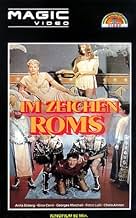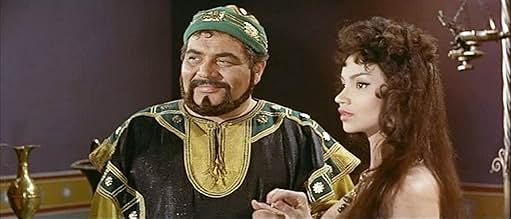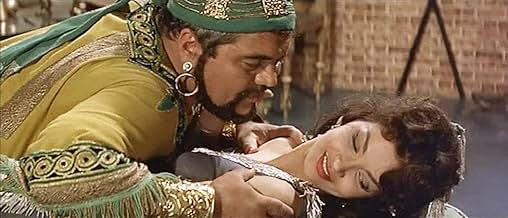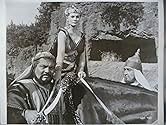NOTE IMDb
5,3/10
375
MA NOTE
Ajouter une intrigue dans votre langueZenobia, Queen of Palmyra, revolts against Rome and defeats the Roman troops - but she makes a big mistake when she falls in love with enemy officer Marco Valerio.Zenobia, Queen of Palmyra, revolts against Rome and defeats the Roman troops - but she makes a big mistake when she falls in love with enemy officer Marco Valerio.Zenobia, Queen of Palmyra, revolts against Rome and defeats the Roman troops - but she makes a big mistake when she falls in love with enemy officer Marco Valerio.
Relja Basic
- Un soldato
- (non crédité)
Angelo Casadei
- Il generale
- (non crédité)
Aristide Catoni
- Un senatore
- (non crédité)
Arturo Dominici
- Un ufficiale di Zenobia
- (non crédité)
Histoire
Le saviez-vous
- AnecdotesOfficials at the American distributor, American-International Pictures, decided that "Sign of the Gladiator" was a more exciting title than "Sign of Rome," even though there are no gladiators in the film. They simply had one of the characters make reference to "gladiator" in a line of the dubbed dialog,
- GaffesIn the desert scenes there are often agaves which were introduced from the Americas only after 1500.
- Citations
Zenobia, Queen of Palmira: If you have lied, the tigers at the temple will have a rich repast.
Marcus Valerius, Roman Consul: Your tigers will have to wait in vain.
- ConnexionsFeatured in Kolossal - i magnifici Macisti (1977)
- Bandes originalesXenobia
(end title song, US dubbed version)
(1959)
Music by Dominic Frontiere
Lyrics by Milton Raskin
Sung by Bill Lee
Played by the Al Simms Sextet
Commentaire à la une
Many legends surround Zenobia ancestry ; she was probably not a commoner and she married the ruler of the city, Odaenathus. Her husband became king in 260, elevating Palmyra to supreme power in the Near East by defeating the Sassanians and stabilizing the Roman East. After Odaenathus' assassination, Zenobia became the regent of her son Vaballathus and held de facto power throughout his reign. In 270, Zenobia launched an invasion that brought most of the Roman East under her sway and culminated with the annexation of Egypt. By mid-271 her realm extended from Ancyra, central Anatolia, to southern Egypt, although she remained nominally subordinate to Rome. However, in reaction to the campaign of the Roman emperor Aurelian in 272, Zenobia declared her son emperor and assumed the title of empress (declaring Palmyra's secession from Rome). Then there happens revolts against Rome and she defeats the Roman troops. But Zenobia (Anita Ekberg) makes a big mistake when she falls in love with enemy officer Marcus Valerius (George Marchal) . Forced into slavery and tortured , Marcus manages to getaway , and come to the presence of the queen, offering her his services. They fall in love, which complicates his task, and his loyalty towards Rome that has sent General Marcello (Alberto Farnese) to defeat her. Marcus will help the Romans to conquer her country , but he will also save her life from a coup led by the treacherous Zemanzius (Folco Lulli).
This Sword-and sandals movie is plenty of adventures , emotions, thrills , sword-play , impressive battles, atmospheric settings , powerful score by prolific Angelo Francesco Lavagnino and colorful scenarios well photographed by Luciano Trasatti , shot mostly on location in Zagreb, Croatia. In Nel segno di Roma (1959) stands out a stunning main and support cast with plenty of notorious Italian actors. The motion picture was professionally directed by Guido Brignone assisted by Riccardo Freda and Michelangelo Antonioni , though it has a lot of flaws and gaps.
If the picture hasn't historical perspective , the historical events about this known are the following ones : Zenobia was a cultured monarch and fostered an intellectual environment in her court, which was open to scholars and philosophers. She was tolerant toward her subjects and protected religious minorities. The queen maintained a stable administration which governed a multicultural multiethnic empire. Zenobia married Odenato , around 266 had a common son, Lucius Iulius Aurelius Septimius Vaballathus Atenodoro, better known as Vabalato. In 267 her husband and her stepson were murdered, her respective nephew and cousin Meonius was accused, for which Zenobia sentenced him to death. Her son Vabalato was then only one year old, so Zenobia succeeded her husband and ruled Palmyra as regent for the minor. Both were awarded the honorary titles of Augusta and Augusto. After the death of Gallienus in 268 and seeing that her successor, Claudius the Gothic, had to dedicate all his efforts to countering a Gothic invasion, Zenobia revolted at Palmyra and tried to create her own empire. Her stated goal was to protect the Eastern Roman Empire from the Sasanian Empire, for the peace of Rome, however, her efforts significantly increased the power of her throne. Rome, involved in a new period of chaos due to the different successions, left the queen of Palmyra, who was well established in her kingdom, to try to aspire to create a third empire, with the intention of dominating the two empires that flanked her. Zenobia fortified and beautified the city of Palmyra, which then had a population of over 150,000. The walls surrounding the city were said to be 21 kilometers in circumference. It had an avenue guarded by large Corinthian columns over 15 meters high. It was full of beautiful temples, monuments, gardens and public buildings, among them the Temple of the Sun stood out. In Palmyra about two hundred statues could be found on its columns and on the walls of the agora. Zenobia was conquering new territories, increasing the territory of the Empire of Palmyra in memory of her husband and as a legacy to her son. Zenobia made expeditions with her great army and conquered Egypt , Anatolia as far as Ancyra and Chalcedon, and later Syria, Palestine, and Lebanon. In her short-lived empire, Zenobia seized trade routes vital to the Romans. The Emperor Aurelian, who came to the throne in 270, after stabilizing the Danube border, finally decided to launch a military campaign against it. He sent some of his forces into Egypt and the bulk of his army east through Asia Minor. Zenobia had a large army, made up of her archers and cataphracts commanded by two generals, Zabdas and Zabbai. But Aurelian conquered Egypt and sent his forces into Syria. Zenobia was defeated at the battle of Emesa (present-day Homs), and withdrew to Palmyra, where it was besieged by Aurelian in 272. Palmyra had stocked up on food and relied on the strength of her excellent archers, hoping to hold out for months, but thanks Against the Arab chiefs of the desert, whom Zenobia had disdained, Aureliano overcame the resistance of the city. Zenobia and her son escaped from there on a camel with the help of the Sassanids, but were captured on the Euphrates River by Aurelian's horsemen, and ordered to be taken to Rome. Zenobia's short reign over Egypt and the Palmyrene Empire was over. The remaining Palmyrenes who refused to surrender were captured and executed on Aurelian's orders. She battled the Roman Empire , but the Romans were victorious after heavy fighting; the queen was besieged in her capital and captured by Aurelian, who exiled her to Rome, where she spent the remainder of her life. Zenobia died after 274, and many tales have been recorded about her fate. Her rise and fall have inspired historians, artists and novelists, and she is a patriotic symbol in Syria.
This Sword-and sandals movie is plenty of adventures , emotions, thrills , sword-play , impressive battles, atmospheric settings , powerful score by prolific Angelo Francesco Lavagnino and colorful scenarios well photographed by Luciano Trasatti , shot mostly on location in Zagreb, Croatia. In Nel segno di Roma (1959) stands out a stunning main and support cast with plenty of notorious Italian actors. The motion picture was professionally directed by Guido Brignone assisted by Riccardo Freda and Michelangelo Antonioni , though it has a lot of flaws and gaps.
If the picture hasn't historical perspective , the historical events about this known are the following ones : Zenobia was a cultured monarch and fostered an intellectual environment in her court, which was open to scholars and philosophers. She was tolerant toward her subjects and protected religious minorities. The queen maintained a stable administration which governed a multicultural multiethnic empire. Zenobia married Odenato , around 266 had a common son, Lucius Iulius Aurelius Septimius Vaballathus Atenodoro, better known as Vabalato. In 267 her husband and her stepson were murdered, her respective nephew and cousin Meonius was accused, for which Zenobia sentenced him to death. Her son Vabalato was then only one year old, so Zenobia succeeded her husband and ruled Palmyra as regent for the minor. Both were awarded the honorary titles of Augusta and Augusto. After the death of Gallienus in 268 and seeing that her successor, Claudius the Gothic, had to dedicate all his efforts to countering a Gothic invasion, Zenobia revolted at Palmyra and tried to create her own empire. Her stated goal was to protect the Eastern Roman Empire from the Sasanian Empire, for the peace of Rome, however, her efforts significantly increased the power of her throne. Rome, involved in a new period of chaos due to the different successions, left the queen of Palmyra, who was well established in her kingdom, to try to aspire to create a third empire, with the intention of dominating the two empires that flanked her. Zenobia fortified and beautified the city of Palmyra, which then had a population of over 150,000. The walls surrounding the city were said to be 21 kilometers in circumference. It had an avenue guarded by large Corinthian columns over 15 meters high. It was full of beautiful temples, monuments, gardens and public buildings, among them the Temple of the Sun stood out. In Palmyra about two hundred statues could be found on its columns and on the walls of the agora. Zenobia was conquering new territories, increasing the territory of the Empire of Palmyra in memory of her husband and as a legacy to her son. Zenobia made expeditions with her great army and conquered Egypt , Anatolia as far as Ancyra and Chalcedon, and later Syria, Palestine, and Lebanon. In her short-lived empire, Zenobia seized trade routes vital to the Romans. The Emperor Aurelian, who came to the throne in 270, after stabilizing the Danube border, finally decided to launch a military campaign against it. He sent some of his forces into Egypt and the bulk of his army east through Asia Minor. Zenobia had a large army, made up of her archers and cataphracts commanded by two generals, Zabdas and Zabbai. But Aurelian conquered Egypt and sent his forces into Syria. Zenobia was defeated at the battle of Emesa (present-day Homs), and withdrew to Palmyra, where it was besieged by Aurelian in 272. Palmyra had stocked up on food and relied on the strength of her excellent archers, hoping to hold out for months, but thanks Against the Arab chiefs of the desert, whom Zenobia had disdained, Aureliano overcame the resistance of the city. Zenobia and her son escaped from there on a camel with the help of the Sassanids, but were captured on the Euphrates River by Aurelian's horsemen, and ordered to be taken to Rome. Zenobia's short reign over Egypt and the Palmyrene Empire was over. The remaining Palmyrenes who refused to surrender were captured and executed on Aurelian's orders. She battled the Roman Empire , but the Romans were victorious after heavy fighting; the queen was besieged in her capital and captured by Aurelian, who exiled her to Rome, where she spent the remainder of her life. Zenobia died after 274, and many tales have been recorded about her fate. Her rise and fall have inspired historians, artists and novelists, and she is a patriotic symbol in Syria.
Meilleurs choix
Connectez-vous pour évaluer et suivre la liste de favoris afin de recevoir des recommandations personnalisées
- How long is Sign of the Gladiator?Alimenté par Alexa
Détails
- Date de sortie
- Pays d’origine
- Langue
- Aussi connu sous le nom de
- Sign of the Gladiator
- Lieux de tournage
- Sociétés de production
- Voir plus de crédits d'entreprise sur IMDbPro
- Durée1 heure 38 minutes
- Rapport de forme
- 2.35 : 1
Contribuer à cette page
Suggérer une modification ou ajouter du contenu manquant

Lacune principale
By what name was Sous le signe de Rome (1959) officially released in India in English?
Répondre































